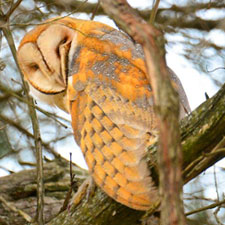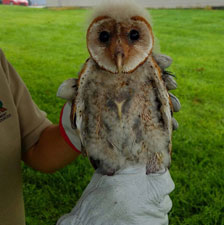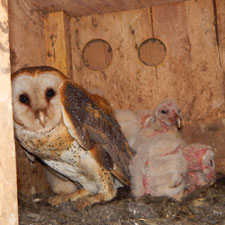Main Content
Article
Barn Owl
- View live video of an Indiana nesting pair
- Learn how you can help barn owls
- Step-by-step Barn Owl Nest Box Construction Guide

General characteristics
Barn owl physical characteristics
- The barn owl (Tyto alba) has a distinctive, heart-shaped face with dark eyes.
- They have long scaly legs and no ear tufts.
- This medium-sized owl stands around 16 inches tall.
- They have whitish underparts and buffy light-brown upperparts.
- Weight ranges from 1 to 1.5 lbs.
- The oldest known wild barn owl was 15.4 years old, from Ohio.
- Barn owl females tend to have more spots on the chest.
Barn owl behavioral characteristics
- Barn owls are nocturnal, roosting during the day in manmade structures (like barns and grain silos), caves, or dense trees.
- Barn owls don’t hoot. Their calls at night consist of eerie screams or raspy hissing sounds. However, more common owl species also screech and scream. A screeching owl is not necessarily a barn owl.
- Barn owls have keen night vision and acute hearing abilities, allowing them to locate rodents and other small mammal prey in complete the darkness.
- Farmers enjoy having barn owls around because of their superior abilities as a mouser.
Distribution and Abundance
The barn owl is the most widely distributed of all owls and is found on all continents except Antarctica. Ill-equipped for cold weather, barn owls are much more common in southern Indiana. Although barn owls occasionally occur in northern Indiana, most recent nests known have been in the southern half of the state. In Indiana and many other Midwestern states, this once-common, rural inhabitant is now rare, and the species is considered endangered by many state wildlife agencies. Fewer than 50 nests are found annually in Indiana.
Barn owls need large areas of pasture, hayfields, grasslands or wet meadows that have populations of meadow voles, their favorite food.
For breeding habitat, feeding areas must be near a nest site consisting of a suitable hollow or cavity in a tree or an appropriate man-made substitute. Nests have been found in silos, water towers, belfries and building steeples.
Properly designed nest boxes offer superior places for nesting and roosting and are readily accepted. Today’s farms consist of large fields of corn and soybeans with few idle or pasture areas. Old wooden barns are disappearing and being replaced by pole barns which offer fewer points of access. In an effort to provide barn owls with secure nesting sites that are protected from predators, the DNR has built more than 400 nest boxes and erected them in barns and other structures with suitable habitat over the past 30 years.
Although the loss of nesting sites, grasslands and pastures is responsible for the decline in barn owl numbers, many other factors are responsible for deaths of barn owls. Great horned owls are the barn owl's primary natural enemy. This common, large owl can easily overpower and kill a barn owl. Humans are responsible for some deaths each year as owls collide with vehicles or are illegally shot. Poisons used to kill rodents may also affect barn owls when they eat the affected mice. Cold winters with snow cover causes mortality, and summer droughts, which reduce mouse populations, affect reproduction success and survival.
Reproduction

Barn owls have a long breeding season which begins as early as March and may last until October. Barn owls may nest more than once during the year. No nest is constructed, although barn owls sometimes burrow between bales of hay. Clutch sizes are large with three to 11 white eggs laid. Incubation lasts for 30 to 34 days and begins almost immediately after the first egg is laid, so a brood of barn owls may differ in age by almost two weeks.
Unless food is in great abundance, the younger chicks are unable to compete with their stronger siblings and die. Generally, three or four young survive the nesting period and leave the nest at 8 to 10 weeks of age. Barn owls widely disperse after they leave the nest, but some winter in Indiana.
Food Habits
Barn owls are strictly night hunters and feed on a variety of small mammals and, rarely, small birds.
Their most common diet items are:
- Meadow and prairie voles.
- White-footed mice.
- Deer mice.
- House mice.
- Shrews.
- Some small birds, like house sparrows and starlings.
A pair of barn owls may require as many as 1,000 mice and voles during the nesting season to feed themselves and their growing brood. Barn owls are secretive and the best way to detect them is to find their distinctive pellets. These consist of a compact mass of hair, feathers and bones and represent the undigestible regurgitated portion of their meal.
Status
The barn owl (Tyto alba) is a state-endangered species . In 2017, only 43 barn owl nests were reported statewide. The decline is due to the loss of grassland habitat. Barn owls get their name because nests are often placed in barns.
Management

Barn owls are tolerant of living close to people, and they respond well to management. Since 1984, wildlife biologists within the Division of Fish & Wildlife have has been investigating reports of barn owls and have installed more than 400 boxes for nesting. By placing these boxes in areas with adequate feeding habitat, barn owls can have a secure nesting place. The box is designed so that barn owls are safe from raccoons and other nest predators. By cleaning out debris from the nest box prior to the nesting season, and not disturbing the owls while they are present, boxes may be used repeatedly for many years.
Want to help barn owls?
Barn owl nest boxes and nest monitoring in Indiana is funded, in part, by citizen donations to the Indiana Nongame Wildlife Fund. To support this project and others like it, visit our donate page.
